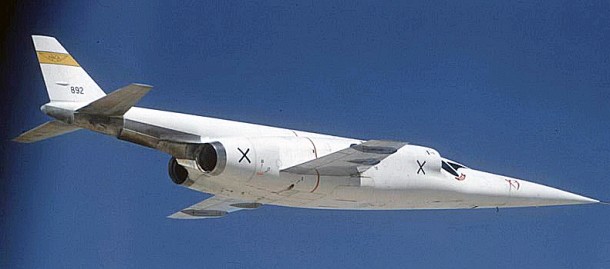
Sixty years ago today, the USAF/Douglas X-3 Stiletto research aircraft encountered a violent dynamic instability during a flight test maneuver. NACA test pilot Joseph A. Walker was able to successfully recover the aircraft from this flight upset known as Inertial Roll Coupling.
The X-3 was designed to fly at speeds up to Mach 2. The aircraft was approximately 67 feet in length and had a wing span on the order of 23 feet. Aircraft gross take-off weight was 23,840 pounds.
A pair of Westinghouse J46-WE-1 turbojets were intended to power the X-3. However, protracted developmental problems and installation issues with these powerplants would eventually prevent their use in the aircraft.
The X-3 was ultimately outfitted with a pair of Westinghouse J34-WE-17 turbojets. The result was that the X-3 was now grossly underpowered and could barely fly supersonically. Indeed, the Stiletto’s maximum demonstrated Mach number was 1.21 which was achieved in a 30-deg dive!
Notwithstanding the above, the X-3 took to the air 54 times between October 1952 and May 1956 for the purpose of conducting transonic flight research. However, it would be on the type’s 43rd flight that the X-3 would make perhaps its most important contribution to aviation.
On Wednesday, 27 October 1954, Joe Walker took-off in the X-3 (S/N 49-2892) from Edwards Air Force Base, California. At Mach 0.92 and 30,000 feet, Walker applied left aileron at fixed-rudder in an effort to develop a rapid roll response. To Walker’s utter amazement, the X-3 went wild in both pitch and yaw.
Although it seemed to last much longer, Walker was able to recover control of the X-3 within 5 seconds of his initial left aileron input. In true test pilot fashion, Walker again made an abrupt rudder-fixed left aileron input at Mach 1.05. The same thing happened. However, this time the aircraft’s motions were more violent.
Happily, Walker again recovered control of the X-3. Having had enough of flight test frontiersmanship for one day, the intrepid Walker uneventfully recovered the experimental aircraft back at Edwards.
The phenomenon that Joe Walker and the X-3 encountered that day in 1954 is known as Inertial Roll Coupling. It is a resonant divergence in either pitch or yaw due to the presence of roll rate. Aircraft like the X-3, which have low longitudinal and/or directional static stability as well as high pitch-to-roll and yaw-to-roll moment of inertia ratios, are especially susceptible to this phenomenon.
As a postscript to our story, the phenomenon of Inertial Roll Coupling had been hypothesized by the NACA’s William H. Phillips back in June of 1948. For Joe Walker in October of 1954, engineering theory would become flight test fact in a few terrifying seconds high in the skies over Edwards Air Force Base.
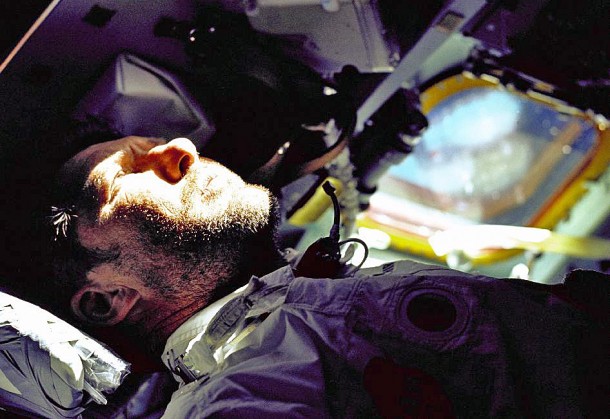
Forty-six years ago this month, NASA successfully conducted the first manned Apollo Earth-orbital mission with the flight of Apollo 7. This mission was a critically-important milestone along the path to the first manned lunar landing in July 1969.
The launch of Apollo 7 took place from Launch Complex 34 at Cape Canaveral Air Force Station, Florida at 15:02:45 UTC on Friday, 11 October 1968. The flight crew consisted of NASA astronauts Walter M. Schirra, Donn F. Eisele, and R. Walter Cunningham. Their primary goal was to thoroughly qualify the new Apollo Block II Command Module (CM) during 11 days in space.
Apollo 7 was not only the first flight of the Block II CM, but in fact the first manned mission in the Apollo Program. Apollo 7 also featured the first use of the Saturn IB launch vehicle in a manned mission. Apollo 7′s critical nature stemmed from the tragic Apollo 1 fire that took the lives of Virgil I. (Gus) Grissom, Edward H. White II, and Roger B. Chaffee on Friday, 27 January 1967.
The Apollo 1 fire was attributed to numerous deficiencies in the design, construction, and testing of its Block I CM. The Block II spacecraft flown on Apollo 7 was a major redesign of the Apollo Command Module and was in every sense superior to the Block I vehicle. However, it had taken 21 months to return to flight status and the Nation’s goal of a manned lunar landing within the decade of the 1960′s was in serious jeopardy.
The Apollo 7 crew orbited the Earth 163 times at an orbital altitude that varied between 125 and 160 nautical miles. In that time, they rigorously tested every aspect of their Block II CM. This testing included 8 firings of the Service Propulsion System (SPS) while in orbit. Apollo 7 splashdown occurred in the Atlantic Ocean near the Bermuda Islands at 11:11:48 UTC on Tuesday, 22 October 1968.
The Nation’s Lunar Landing Program overwhelmingly got the unqualified success that it desperately needed from the Apollo 7 mission. The Apollo Block II CM would provide yeoman service throughout the time of Apollo. The spacecraft would also go on to see service in the Skylab and Apollo-Soyuz Test Project programs.
While the technical performance of the Apollo 7 crew was unquestionably superb, their interaction with Mission Control at Johnson Spacecraft Center (JSC) in Houston, Texas was quite strained. The crew suffered from head colds through much of the mission and the food quality was poor. Coupled with Houston’s incessant attempts to cram more tasks into each moment of the mission, Apollo 7 Commander Schirra took control of his ship and made the ultimate decisions as to what work would be performed onboard the spacecraft.
The flight of Apollo 7 would be Wally Schirra’s last mission in space as he had announced prior to flight. Schirra holds the distinction of being the only astronaut to have flown Mercury, Gemini, and Apollo missions.
Interestingly, Apollo 7 was not only Schirra’s last time in space, but it was Donn Eisele’s and Walt Cunningham’s first and last space mission as well. That there is a direct connection between this historical fact and the crew’s insubordinative behavior during Apollo 7 is obvious to the inquiring mind.
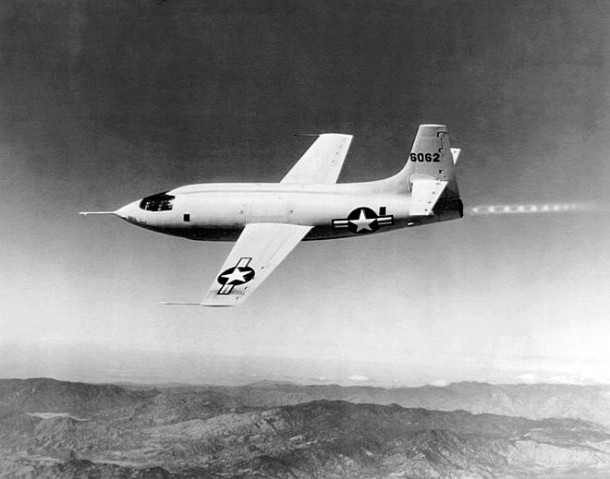
Sixty-seven years ago to the day, USAF/Bell XS-1 Ship No. 1 (S/N 46-062) officially exceeded the speed of sound for the first time. With Air Force Captain Charles E. “Chuck” Yeager at the controls, the rocket-powered flight research aircraft reached a maximum speed of 700 mph (Mach 1.06) at 45,000 feet.
Bell Aircraft Corporation of Buffalo, New York built three copies of the XS-1 under contract to the United States Army Air Forces (USAAF). The aircraft were designed to approach and then fly beyond the speed of sound.
The Bell XS-1 was 31 feet in length and had a wing span of 28 feet. Gross take-off weight was around 12,500 lbs. The aircraft had an empty weight of about 7,000 lbs. Propulsion was provided by a Reaction Motors XLR-11 rocket motor capable of generating a maximum thrust of 6,000 lbs.
On the morning of Tuesday, 14 October 1947, the XS-1 (S/N 46-062) dropped away from its B-29 mothership (S/N 45-21800 ) as the pair flew at 220 mph and 20,000 feet. In the XS-1 cockpit was USAAF Captain and World War II ace Charles E. Yeager. The young test pilot had named the aircraft Glamorous Glennis in honor of his wife.
Following drop, Yeager sequentially-lit all four XLR-11 rocket chambers during a climb and push-over that ultimately brought him to level flight around 45,000 feet. The resulting acceleration profile propelled the XS-1 slightly beyond Mach 1 for about 20 seconds. Yeager then shutdown the rocket, decelerated to subsonic speeds, and landed the XS-1 on Muroc Dry Lake at Muroc Army Airfield, California.
The world would not find out about the daring exploits of 14 October 1947 until December of the same year. As it was, the announcement came from a trade magazine that even today is sometimes referred to as “Aviation Leak”.
Today, Glamorous Glennis is prominently displayed in the Milestones of Flight hall of the National Air and Space Museum located in Washington, DC. For his significant test piloting efforts in breaking the sound barrier, Chuck Yeager was a co-recipient of the 1948 Collier Trophy.
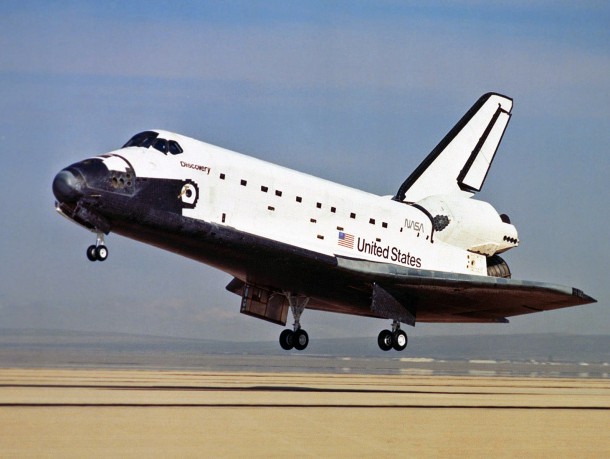
Twenty-six years ago this month, the Space Shuttle Discovery and her five man crew landed on Rogers Dry Lake at Edwards Air Force Base to successfully complete the Return-to-Flight (RTF) mission of STS-26. The flight signaled a resumption of the Space Shuttle Program after a 32-month hiatus in manned spaceflight resulting from the Challenger disaster.
Well chronicled is the tragic loss of the Space Shuttle Challenger and its crew of seven on Tuesday, 28 January 1986. Following lift-off at 16:38 UTC from Cape Canaveral’s LC-39B, the launch vehicle distintegrated 73 seconds into flight. The presidentially-appointed Rogers Commission concluded that the primary cause was failure of an O-ring seal in a field joint of the right Solid Rocket Booster (SRB).
While the SRB O-ring failure was the physical cause of the Challenger mishap, the Rogers Commission brought to light a more fundamental and disturbing reason for the tragedy. Specifically, the very decision to launch Challenger on that unusally cold January morning in Florida was fundamentally flawed.
As chillingly delineated in Dianne Vaughan’s “The Challenger Launch Decision”, a culture of deviance with respect to Shuttle flight safety issues had slowly developed at NASA. Pressure to launch, scarce resources and organizational disconnects contributed to NASA management’s blind spot when it came to Shuttle flight safety. The SRB contractor was culpable as well and for the same reasons.
Following redesign and testing of the SRB field joints and the implementation of a myriad of other fixes, NASA prepared to return the Shuttle to flight. The mission was designated as STS-26. To the Space Shuttle Discovery would go the honor of and the responsibility for flying the RTF mission. STS-26 was to be a five day orbital mission.
A five-member crew was selected by NASA to fly STS-26. Each crew member had spaceflight experience. You remember their names. Mission Commander Frederick H. “Rick” Hauck, Pilot Richard O. Covey, and Mission Specialists John M. “Mike” Lounge, George D. “Pinky” Nelson and David C. Hilmers.
Discovery and her brave crew lifted-off from at 15:37 UTC on Thursday, 29 September 1988 from the very same location that Challenger did; LC-39B at Cape Canaveral, Florida. Millions watched that day. Some were in the big crowds that formed in and around the Cape complex. Most observed the event on television. Many prayed.
All who watched Discovery lift-off that day could not forget the previous Shuttle flight. Indeed, they remembered what happened just after the CAPCOM’s call: “Challenger, go at throttle-up.” (Ironically, Richard Covey was the CAPCOM who made that very call.) Today, they heard a similar call over the Shuttle communications network: “Discovery, go at throttle-up.” A collective breath was held. After throttle-up, Discovery continued all the way to orbit. YES!!!
The mission itself seemed to be anti-climatic. A Tracking and Data Relay Satellite (TDRS) was deployed from Discovery’s payload bay to replace the one lost in the Challenger explosion. A multitude of space experiments was conducted by the crew. Fairly standard stuff. Only deboost, the rigors of reentry and the typical dead-stick landing lay ahead.
Discovery landed on Runway 17 at Edwards Air Force Base on Monday, 03 October 1988. Main gear touchdown occurred at 16:37 UTC. Approximately, 450,000 American’s witnessed Discovery’s landing in person. A few who did had witnessed its launch in person as well.
The emotion that attended Discovery’s landing in October 1988 was simply overwhelming. Indeed, the experience was an integral part of the healing process for a Nation that still grieved the loss of Challenger and her crew. A Time magazine cover page headline the following week excitedly read: “Whew! America Returns to Space” And indeed it had.
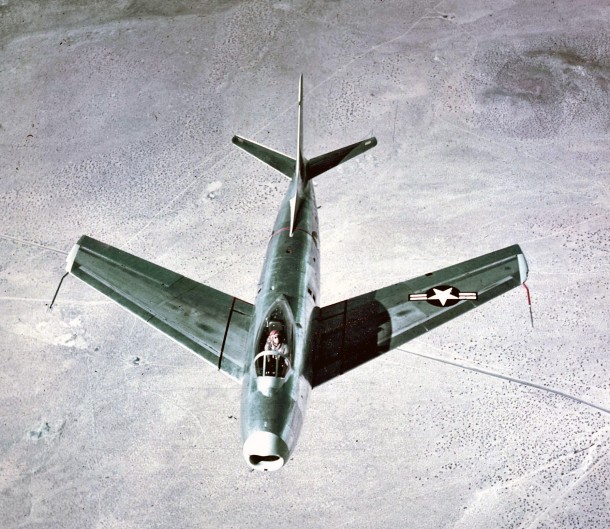
Sixty-seven years ago today, the swept-wing XP-86, the initial version of the famed USAF/North America F-86 Sabre, began flight testing at what is now Edwards Air Force Base. The iconic Mig Alley legend would be produced in numerous variants and ultimately rack-up a total production run of nearly 10,000 aircraft worldwide.
In the waning days of World War II, the United States Army Air Force (USAAF) issued the requirements for a new high-speed, jet-powered fighter/interceptor aircraft. North American Aviation (NAA) captured the USAAF’s attention with a prototype swept-wing aircraft known as the XP-86. The ”X” designation was shorthand for Experimental while the “P” stood for Pursuit.
The XP-86 (later designated as the XF-86 where “F” stood for Fighter) was the first United States fighter to incorporate wing sweep. The key benefit derived from sweeping the wings was to greatly reduce transonic wave drag. Based on aerodynamics data captured from the defeated Third Reich, NAA engineers designed the XF-86 with a wing sweep of 35 degrees.
A drawback to using wing sweep is that low-speed flight characteristics are adversely affected. The principal detrimental effect being a reduction in lift. However, NAA solved this problem by the incorporation of leading edge slats to enhance lift production at low speed.
The XF-86 measured roughly 37-feet both in length and wingspan. Empty weight was some 12,000 lbs. Power was provided by a Chevrolet J35-C-3 turbojet that generated a paltry 3,750 pounds of thrust. Later variants of the Sabre would be powered by jet engines generating nearly 10,000 pounds of thrust.
On Wednesday, 01 October 1947, XF-86 No. 1 (S/N 45-59597) took to the air for the first time from Muroc Army Air Field, California. USAAF Major and WW II 16-kill combat ace George S. “Wheaties” Welch was at the controls of the XF-86. While the evidence is largely anecdotal, it is entirely possible that Welch exceeded the speed of sound during a dive on that long-ago first flight test.
The case of George Welch is an intriguing sub-plot of the F-86 Sabre story. Welch was stationed at Pearl Harbor on 07 December 1941. He was one of the very few American pilots to get in the air and fight the attacking Japanese forces. Numerically overwhelmed, he nontheless splashed four (4) enemy aircraft and lived to fly and fight another day.
Welch served three (3) combat tours in WW II for a total of 348 combat missions. After leaving the service in 1944, he joined North American Aviation as a test pilot. Welch progressed quickly and became NAA’s Chief Test Pilot. This path ultimately led to Welch flight testing the XP-86 Sabre.
Although denied verification in official Air Force records, both oral history and compelling circumstantial evidence suggest that George Welch exceeded Mach 1 at least twice before the Bell XS-1 did so on Tuesday, 14 October 1947.
Incredibly, the first instance of Welch and the XF-86 exceeding Mach 1 was on the occasion of its first flight test! Welch dove the aircraft from 35,000 feet and reportedly generated a weak sonic boom.
The second instance of Mach 1 exceedance reportedly occurred on Tuesday, 14 October 1947. This time Welch dove the XF-86 from 37,000 feet and generated a stronger sonic boom. Apparently, this event took place just before the Bell XS-1, with USAAF Major Charles E. “Chuck” Yeager at the controls, achieved Mach 1.06 later that same morning.
Welch was never officially credited with being the first to achieve supesonic flight. A number of reasons account for this circumstance. First, his aircraft was not instrumented properly to verify flight performance at quasi-supersonic speeds. Additionally, Welch’s aircraft was not tracked by radar.
In addition to the technical reasons cited above, there was political intrigue surrounding Welch’s supersonic dive flights as well. NAA (and thus Welch) had been ordered not to exceed Mach 1 before the rocket-powered Bell XS-1 did so. Perhaps the only concession accorded Welch was that USAF later referred to Yeager’s historic superonic flight as the first time the sound barrier was broken in level flight.
While all of this is quite interesting, it must be stated that the above claims meet with vehement disagreement by those who hold that the historical record is unassailably true. However, while claiming absolute objectivity, the motivations of at least some of the critics appear to be political and self-serving. Suffice it to say that adherents in both camp remain adamant that theirs is the correct case!
George Welch went on to a distinguished, but all too brief flight test career. On Monday, 25 May 1953, he became the first man to exceed Mach 1 in level flight in a jet-powered production aircraft. That aircraft was the North American F-100 Super Sabre. Welch perished on Tuesday, 12 October 1954 when his YF-100A went out of control and distintegrated during a 7-g pull-up at Mach 1.55.
For its part, the F-86 Sabre ultimately served long and well in the air forces of the United States and a host of other western-friendly nations. Perhaps its greatest claim to fame accrues from the type’s remarkable aerial combat perfromance in the Korean War. Indeed, despite being numerically bested by Soviet-built MIG-15 aircraft, the official record shows that USAF pilots made 792 kills flying the Sabre. Compared with 76 kills made by the opposition, the Sabre registered a phenomenal 10:1 kill ratio.





